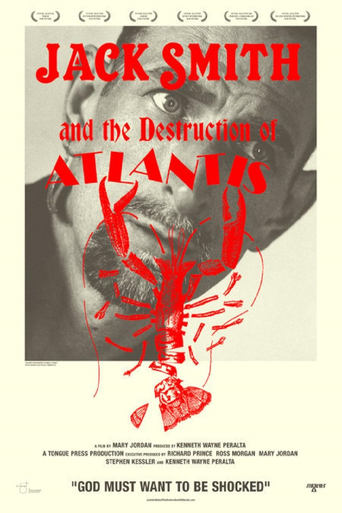

okay, so we have Jack Smith... Jack who? Jack Smith, yes, the cult director of such movies as 'Flaming Creatures' (in fact, his only complete movie he ever made). you're reading this, probably because you know his style and you want to learn more about who Jack Smith (and, off course, what he did and mad, because a lot of his 'pictures' remain only as pictures somewhere hidden in a vault, carefully put away like the ring in the Lord of the Rings-trilogy). well, you're on the right address with this documentary. it tells us a lot about the sixties and a lot about Jack Smith, but also about the other experimental movie makes, avant-gardists and art directors. but, and here's the but(t), it shows us less movies of Smith as expected, and too much other stuff that has less to do with Smith than his lifestyle. but that isn't so bad, because it shows Smith as he was, just as he wanted movies to portray realities and not the thing we call fiction, but even beyond that. after viewing this excellent documentary, I have a bit of disappointing feeling, the 'magic' is gone, Jack Smith was only a man and not a cult icon. still, he remains more than a man, he stays to be art. art is as important for him, as it is for us. still, I'm glad I watched this.
... View MoreOverall, Jack Smith reminds me of the Hunter S. Thompson line in Fear & Loathing in Las Vegas about his lawyer Dr. Gonzo: "One of God's prototypes. A high-powered mutant not even considered for mass production: too weird to live, and too rare to die." Smith, growing out of the rural dregs of Texas depression-era squalor, was fascinated and compelled by expression through impressions of the outcasts. A kind of half garbage-man and half pre-Andy Warhol absurdist, Smith first went through photography, where he made up photos as if in little cinematic vignettes through "found" art (the garbage) as well as "found" actors as it were. His amateur techniques and stringently independent tactics of rounding up people who were cast aside in lower east side Manhattan (one of which a transvestite, Mario Montez, named after one of Smith's idols Maria Montes), and in blending the fantastical with reality. Warhol ends up getting a chunk of the story in Destruction of Atlantis, and not without good reason; Warhol was once quoted as saying Smith was the only one he would copy from, and one sees a very strange push and pull short-lived collaboration between Warhol- whom Smith saw as the establishment already with the money he kept on receiving for his work- as the two minds were too much into their own styles to really meet at one point.There is also what might be the most fascinating section of the film where the story of Flaming Creatures and Smith's rocky film-making not-quite career takes shape. "Creatures", from the clips presented, is a manically profound farce that is like getting the roughest 16mm glimpse at Smith's consciousness, as it is unkempt and unapologetically sexually ambiguous (to say it's outrageous and improvisational is putting it lightly), but it's alive and buzzing with a sense of humor and depraved poetry. It was as well, upon its original underground release, banned and labeled obscene by New York City, and banned in 22 states and four countries. This became something of a big lament for Smith that affected the rest of his life, more or less, in due to how the double-edged sword of film criticism worked him. Jonas Mekas, the first critic at the Village Voice, who championed the film across the country, getting himself arrested in the process, as well as to filmmakers like Fellini, is put in a sort of biased light by Mary Jordan. Mekas got most of the money from the screenings, with Smith getting next to nothing, and from there on in whenever Smith tried to make new films people would say "we just want Flaming Creatures." On the one hand it's a little un-fair to judge all film criticism the way we're meant to be shown here with the Mekas/Smith drama, but on the other hand without Mekas Smith would be even less known than he did with him.But Smith was through and through a self-created visual anarchist, an originator of many of the avant-garde forms of film-making and art in the 1960s and beyond, and bizarre flaunter of what he "owned", which was only his self-creations (his dingy , uniquely movie-studio-fantasy designed apartment and incomplete films). And in this as her subject, Jordan makes a very convincing case for Smith as one of those truly sad but funny stories of an artist. As one sees through the interviews with friends, critics, admirers, actors, past possible lovers and closest confidants, as well as the phantasmagoria of bits and pieces of his work and audio clips, Smith made small waves when compared to the more noted experimental filmmakers of his time, but in such small circles the effect was extraordinary.
... View MoreWhile this documentary is a much-needed portrait of a very interesting artist and individual, it is the archival footage and clips from Jack Smith's own films which make the film valuable. The film itself is somewhat clumsily structured, and the modern-day interviews look like they were shot by a monkey (constant zooming in and out, jerky movement as the camera is moved from side to side on a tripod, unattractive low angles, etc). I would have liked more details on Jack Smith's personal life, and on his youth. Above all, I left the movie theater feeling like I knew more about Jack Smith's films and how the world reacted (or didn't react) to them, but not much more about the man himself. The doc has sound clips of what is presumably Jack Smith speaking running throughout, but it is never made clear where these sound clips come from (were they part of an interview, when was the interview conducted, etc). Still, the film is worth a look for anyone who is a fan of Jack Smith's work and what it stood for.
... View MoreHighly intelligent and well researched, this film by Mary Jordan and produced by Ken Peralta is the definitive film on Jack Smith. The editing of Jack's art and the art of the film is so well integrated that you not only see the many mediums of Smith but you get a psychological examination of one of the most unknown influences of the 20th century. The 93 minute movie rarely slows down as we see a young mind overflowing with angst and creativity, followed by his influencing of Warhol and later greats like Perry Ferrell and Richard James. I found this in the same special club of great movies like "Crumb" and "Hearts of Darkness: A Filmmaker's Apocalypse." A definite must-see for those unaware of Jack Smith's world or well versed in his art.
... View More